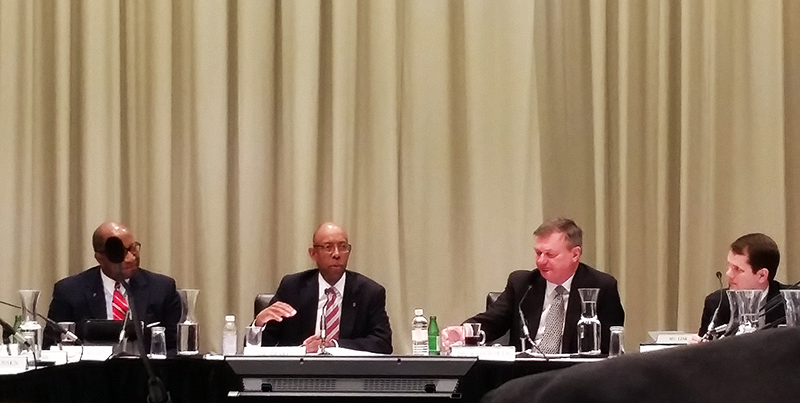
University President Michael Drake speaks during a Board of Trustees meeting on April 8. Credit: Ashley Wilkinson | For The Lantern
The Ohio State Board of Trustees has approved a proposal to freeze fees for in-state students while hiking the prices for out-of-state and international students for another year. Additionally, residence hall fees remain frozen for school year 2016-17, despite an initial proposal to increase them.
In-state tuition and mandatory fees have been frozen since the 2012-13 school year, and since then out-of-state tuition has steadily increased. The Board of Trustees approved another 3.2 percent hike for out-of-state undergraduate students’ tuition, raising the total to $28,229 from $27,365 per academic year.
Additionally, currently enrolled international students will see a 3 percent increase to tuition, raising it from $28,365 per academic year to $29,229 per academic year. International students enrolling with OSU in Autumn Semester 2016 for the first time will pay an extra 2.9 percent from those who enrolled last year, now set to pay $30,169 per academic year instead of $29,305 per academic year.
Mandatory fees affected by the proposal are the instructional, general and student-activity fees.
Mandatory fees that won’t be affected include the recreational, student union and COTA fees, according to the Financial Committee’s meeting documents. Although they will not be frozen for in-state students, the board did not propose any increase or decrease to these fees at the April meeting.
The university decided not to recommend a 2 percent raise in residence hall room rates after University President Michael Drake asked university administrators to consider other ways to reduce or avoid the increase. Even without the increase, OSU room rates remain the highest among Ohio state schools and the second highest in the Big 10, behind only Northwestern.
The Trustees also approved the university to enter into or increase construction and professional-service contracts for several projects.
Service contracts for some of the $41.6 million in upgrades to Ohio Stadium were approved on Friday. The approval to enter into $5 million in contracts comes less than two weeks after Vice President and Director of Athletics Gene Smith announced a multiyear plan to renovate the iconic stadium’s concrete coating on C-deck, to make alterations to premium seating areas and to upgrade B-deck and the stadium’s power systems.
“This total plan, in my view, will significantly enhance our opportunity as we move forward to the future schedules that we have in football to make sure our fans have a fan-friendly environment that will allow us to continue to provide remarkable experiences for our fans,” Smith said during a March 29 press conference.
Renovations are set to occur in phases, beginning in 2017 and ending in 2020, and are set to be funded by auxiliary funds, debt and private donations, according to a university release.
Approval was also granted to enter into $41.1 million in construction contracts for the renovation of Pomerene and Oxley halls. Expected to conclude in 2018, the $59 million project is for Translational Data Analytics, Data Analytics academic program, History of Art, Linguistics and classroom pool. The project will also allow the Office of Disability Services to move out of Pomerene Hall after renovations and into Baker Commons.
Professional-service contracts to the tune of $600,000 were approved to identify and review sites for Wexner Medical Center parking garages. This is part of a $50.6 million project, paid for by auxiliary funds, to construct parking facilities that will serve the medical center.
Trustees also approved $6 million in service and construction contracts for the Ross Heart Hospital’s fourth-floor hybrid operating-room project. Construction contracts were approved for $5.3 million, as well as $700,000 in professional services. The project will include a 2,400-foot addition to the fourth floor of the hospital, as well as renovations to the second floor.


